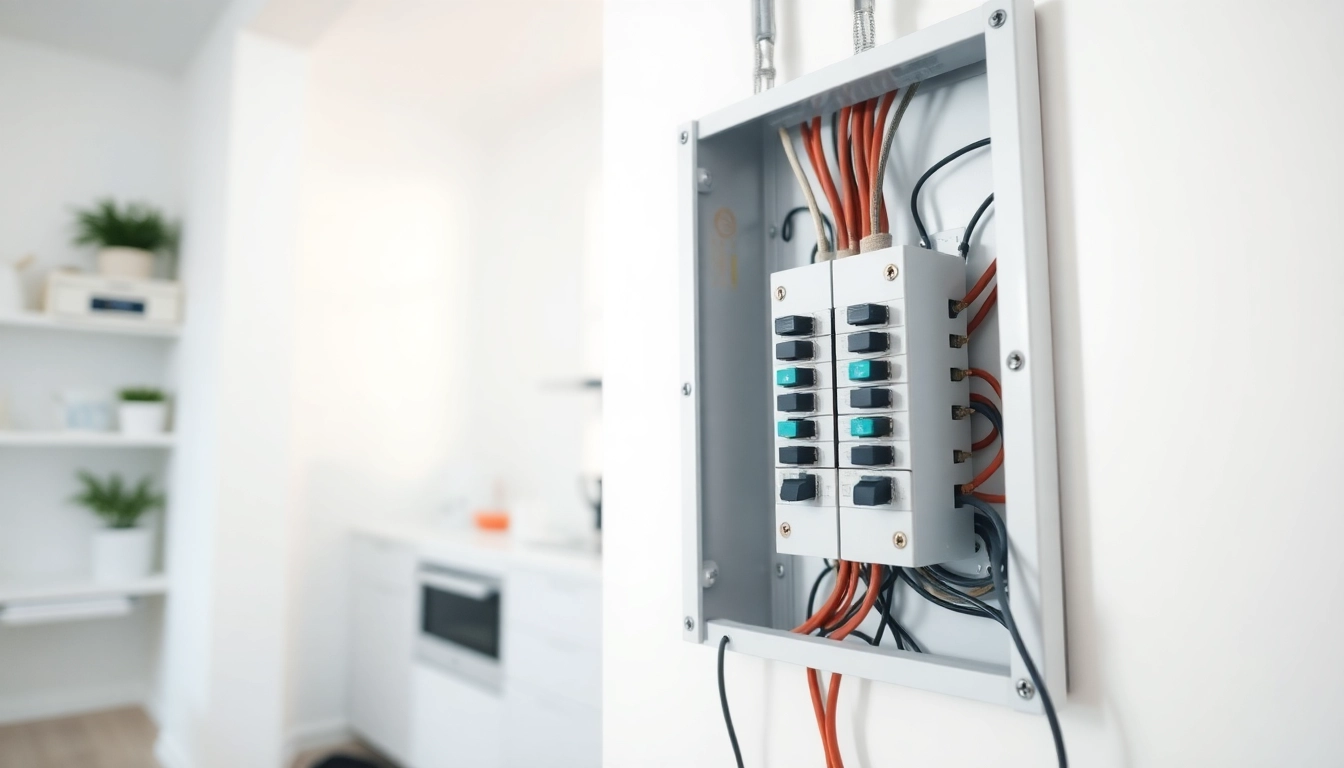Understanding the Electrical Panel: Basics and Components
What is an Electrical Panel?
An Electrical Panel, often referred to as the breaker box, serves as the control center for the electrical system in a home or building. It is responsible for safely distributing electricity throughout the property. Power from the local utility company enters the panel and is then channeled out to various circuits that power everything from lights to appliances. Understanding the functionality and components of an electrical panel is crucial for homeowners, especially when it comes to managing electrical safety and upgrading systems as needs change.
Key Components of the Electrical Panel
The electrical panel consists of several core components:
- Main Breaker: This is the switch that controls the electrical flow from the power source into the panel. It can shut off all power to the home and is crucial for safety.
- Circuit Breakers: These are individual switches that control the electrical flow to separate circuits. They protect each circuit from overload by tripping if too much current flows, preventing potential hazards like house fires.
- Bus Bars: Copper or aluminum bars support the circuits by distributing electricity from the main breaker to the individual circuit breakers.
- Neutral and Ground Bars: These are used to connect all the neutral wires from the circuits to the ground. They play a key role in ensuring that excess electricity is safely directed away from your home.
- Labeling: A critical yet often overlooked aspect, proper labeling of breakers can simplify identifying circuits, which is essential for maintenance and troubleshooting.
How the Electrical Panel Operates
The operation of an electrical panel is straightforward yet vital for home electrical systems. When electricity flows from the utility line into the panel, it first encounters the main breaker, which can either let the power pass or cut it off. From there, each circuit breaker receives power, which is then distributed to specific areas of the home. The designed load of each circuit is carefully calculated, with the panel supporting essential appliances and lighting. Any excess load leads to a breaker tripping, providing a safeguard to prevent electrical fires or circuit damage.
Signs You Need to Upgrade Your Electrical Panel
Increased Power Demands
As homes evolve, so do the energy demands placed on electrical systems. The rise of smart home devices, energy-efficient appliances, and high-demand electronics such as laptops, gaming systems, and home theaters can exceed the capacity of older electrical panels. If homeowners find themselves frequently using multiple devices or experience a shortage of outlets, an upgrade may be essential to manage these demands safely and effectively.
Frequent Breaker Trips
A common indication that it’s time to upgrade your electrical panel is repeated tripping of breakers. While occasional tripping may occur with a sudden surge in electrical load, regular trips indicate that the system is likely struggling to handle the current load. This situation can lead to potential safety issues, including overheating of electrical components and increased fire risk.
Age and Condition of the Electrical Panel
Electrical panels have a lifespan, generally lasting around 25 to 40 years. Older panels may not only struggle with the modern requirements but may also be less efficient and more prone to malfunctions. Signs of wear and tear, corroded or damaged breakers, or scorched wiring point towards the necessity for an upgrade for safety and compliance with current electrical codes.
Choosing the Right Type of Electrical Panel for Your Home
Factors to Consider When Selecting an Electrical Panel
When selecting an electrical panel, various factors should be taken into account:
- House Size: The larger the home, the more circuits will be needed. Assess the total number of circuits required based on fixtures, outlets, and appliances.
- Amperage Needs: Common residential electrical panels range from 100 amps to 400 amps. Determining the proper load calculation can guide homeowners in selecting the right size for their specific energy needs.
- Future Planning: Consider not only current needs but also potential future demands. It’s often wise to overestimate slightly to allow for future electrical demands without an immediate need for another upgrade.
- Local Codes: Always stay updated with local codes and standards; failure to comply can result in fines or issues during inspections.
Comparing Different Electrical Panel Types
There are various types of electrical panels suitable for different home configurations:
- Main Breaker Panel: This type includes a main circuit breaker that shuts off power to the entire panel, providing ultimate control.
- Main Lug Panel: Lacks a main breaker, allowing power to flow directly into circuit breakers. Ideal for homes with separate main switches.
- Subpanels: Used when additional circuits are necessary in certain areas away from the main electrical panel, like a workshops or garages.
How to Determine the Correct Amp Rating
To determine the correct amp rating for your electrical panel, perform a load calculation that considers:
- Total wattage of all appliances and devices.
- Estimated daily usage for major appliances.
- Additional circuits for lighting and small appliance loads.
This process will aid in selecting an electrical panel that can efficiently and safely handle your power requirements.
Steps to Upgrading Your Electrical Panel Safely
Preparing for the Upgrade
Before initiating an upgrade, conduct thorough planning. Document your current setup and list all the circuits in use. This initial preparation can help streamline the installation process and assist the electrician in understanding your needs better.
Hiring a Qualified Electrician
Upgrading your electrical panel is not a DIY project; it requires the expertise of a licensed electrician. Choose a professional who has experience with panel installations and upgrades. Check their credentials, references, and customer feedback to ensure you’re hiring someone qualified.
Common Challenges During Installation
Potential challenges during the installation of a new electrical panel may include:
- Local Code Requirements: Ensure the new panel meets all safety codes and regulations, which can vary by location.
- Space Constraints: If space is limited, it might be necessary to relocate the panel, which can add complexity to the installation.
- System Compatibility: Ensure that the existing wiring is compatible with the new panel.
Anticipating these challenges and working closely with your electrician can mitigate issues and ensure a smooth upgrade process.
Maintenance Tips for Electrical Panels
Regular Inspection and Monitoring
Conduct regular inspections of your electrical panel to check for any signs of wear, corrosion, or loose connections. Monthly checks will help identify potential problems early, ensuring a safer environment. Additionally, ensure that all breakers are properly labeled to simplify identifying circuits during inspections.
Addressing Common Issues
Common issues that may arise from improper maintenance include:
- Tripped Breakers: Investigate the cause of repeated trips as they signal that your system may be overloaded or that components need replacement.
- Brittle or Damaged Wires: Wires that show signs of deterioration need immediate attention to prevent short circuits or fires.
Best Practices for Long-term Safety
To ensure the long-term safety and efficiency of your electrical panel, consider the following practices:
- Ensure the panel is easy to access and not obstructed by storage or furniture.
- Keep the area around the panel free from moisture, excessive heat, and dust.
- Schedule professional inspections every few years to assess the panel’s condition thoroughly.
Investing in proper care and attention to your electrical panel will enhance its lifespan, ensure safety, and provide peace of mind in an increasingly electrified world.



